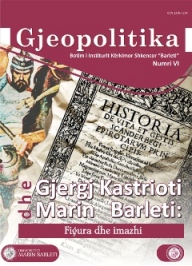Skënderbeu në Historiografinë Gjermane. Një vështrim i Përgjithshëm
Skanderbeg in the German Historiography. A General Overview
Author(s): Edmond MalajSubject(s): History
Published by: Botimet DUDAJ
Keywords: Skanderbeg ; German Historiography; General Overview
Summary/Abstract: In the German speaking world we have books on Scanderbeg starting from XVI century. The main source of the German historiography on Scanderbeg was Marin Barleti’s work “Historia de vita et gesti Skanderbegii”, which was translated by Johannes Pinician in 1533. During XVI century we have some works by German humanists, such as Cuspinianus “On the origin of the Turks”, Levenklaus “The Annales of the Ottoman Sultans” and Camerarius “Two detailed commentaries on the Turks’ affairs” in 1598, where the author refers also to the life of Scanderbeg. In the XVII century, we can mention here the work by the humanist Johanes Lassenius “The Turks’ might mocked by Deity”, based upon Barleti’s book. In XVIII we do not have original works, but only reproductions of the history written by Barleti and encyclopaedic articles referring always to this book. In XIX century, we have some monographs, the fi rst being the book by Wilhelm Becker, fi rstly published in the Berlin magazine “Der Freimütige” under the title “Gjergj Scanderbeg and Murad”. In 1821, this book was published under a new title “Gjergj Scanderbeg and Murad, or Gjergj Scanderbeg, the fortunate forerunner of Alia Pasha of Joannina”. In 1827, an anonimous and philo-hellenist author with the initials G.K, published the study “Gjergj Kastrioti. A sketchy biography of the past times, compared to ours”. The third monograph was by Julius Piskos, “Scanderbeg”, which came out in 1894. Besides these monographs we have numerous other works where we can fi nd indirect informations on Scanderbeg, such as “The history of the Ottoman Empire”, by Hammer von Purgstall in 1827, “The history of the Ottoman Empire in Europe” by Zinkeisen and published in 1840, “The Albanian element in Greece” of 1866 written by Fallmereyer. With regard to the German historiography of the XX century and that of the XXI century, we have “Mehmet the Conqeror”, by Franz Babinger, who is critical of Marin Barleti’s work and “Scanderbeg” by Oliver Jens Schmitt, which is the most detailed study on this fi gure.
Journal: Gjeopolitika
- Issue Year: 2011
- Issue No: 06
- Page Range: 066-076
- Page Count: 11
- Language: Albanian

